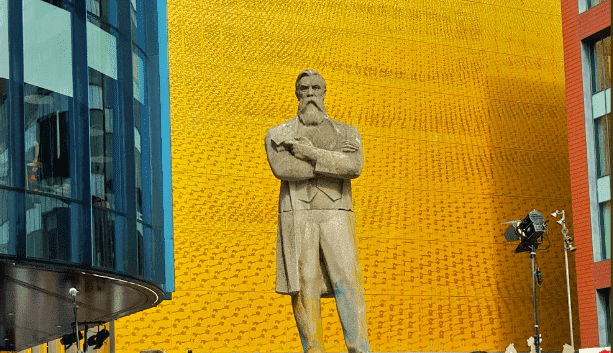Should a 3.5 metre high Soviet statue of Karl Marx’s collaborator and patron Friedrich Engels – brought over from Ukraine five years ago – stay up in central Manchester? The concrete likeness of communism’s co-founder, dating from 1970, lorded over Mala Pereshchepina, a village a few hours drive from Kharkiv, until 2015. In the aftermath of Russia’s annexation of Crimea and the stoking of pro-Russian insurgents in Donbas, Ukraine decreed that all Soviet era symbols be removed – and Marxism’s co-founder was felled there, only to rise again in Manchester.
This Engels from Ukraine was not erected to celebrate Anti-Dühring, his 1877 polemic against the wrong kind of socialist. It and thousands like it throughout the former Soviet Union and communist Central and Eastern Europe were there to show who the masters were: the Communist party, and that they intended to stay in power.
The statue then is a physical manifestation of a wicked system which brought about massive suffering, death, and even in its most benign periods extinguished human autonomy in a cloak of collective drabness. Its very existence is a symbol of Soviet power over Ukraine, probably something we don’t want to celebrate, especially in light of Russia’s current invasion.
History shows all too clearly that the Soviet Union did not turn into the paradise Engels envisioned
When it was moved to Manchester in 2017 some asked what was going on. Dan Hannan said: ‘Communism killed 100 million people. And we’re putting up a statue of Engels’. That sentiment may be a tad unfair as Engels died in 1895 and communists weren’t in a position to engage in mass killing until 1917. But bad ideas have consequences, for which some of the blame must be apportioned to Engels.
With the invasion of Ukraine, objections to the statue and what it means are being taken more seriously. HOME – a publicly-funded arts centre in the heart of Manchester opened in 2015 at a cost of £25 million – outside of which Engels stands declared last week that:
‘In light of the illegal invasion of Ukraine by the Russian army, we are in discussions with the co-commissioners of the artwork Manchester International Festival and the artist Phil Collins about how best to respond’.
The art centre later clarified that they were not suggesting the sculpture should be taken down, but rather that it should be contextualised in the now fashionable way. Yet this forgets the reason why Engels was put on display in the first place. His statue in Manchester was never intended as a homage to the Soviet Union. Instead, it was Engels’ links to Manchester that led to it being rehoused there. Engels’ parents owned a textile mill in Salford, and the young Engels was sent there to manage it. His Manchester observations are the basis of ‘The Condition of the Working Class in England’, one of his most famous works.
Of course, history shows all too clearly that the Soviet Union did not turn into the paradise Engels envisioned in these writings. So, knowing what we know now about communism, does it really make sense to add a new sign ‘explaining’ Engels statue? If so, the obvious option would be to put up plaques detailing the role of such statues in the USSR. Perhaps, too, these could offer an exposition of what was carried out in the name of Engels’ ideology, including the Holodomor, Ukraine’s 1932-33 terror famine.
Maybe, though, there is another way of sending up Engels? Engels’s book ‘The Origin of the Family, Private Property and the State’ is, bizarrely, a paean to meat eating. Adopting the ideas of American anthropologist Lewis Henry Morgan, Engels argues that prehistoric man progresses from various stages of savagery through barbarism to civilisation and that progression from one stage to the next is marked by changing diet. In Engels’ schema when humanity was in its infancy, changing diet played the role that changing economic systems played in Marx’s more familiar trajectory of history.
Humanity, we are told, comes down from the trees of lower stage savagery to be tempted by a diet of ‘crabs, mussels and other aquatic animals’ – and thus moves up to middle stage savagery. Gradually meat eating enters our diet, first through hunting and then animal husbandry; there is even a cannibalistic interregnum. As meat eating increases, we move through various pre-historical stages and gradually become more civilised. At least that is Engels’ argument: ‘the plentiful supply of milk and meat accounts perhaps for the superior development of the Aryan and Semitic races. It is a fact that the Pueblo Indians of New Mexico, who are reduced to an almost entirely vegetarian diet, have a smaller brain…’
Engels – albeit on the basis of bad anthropology and worse science – would have been no fan of vegetarianism, let alone veganism. If the current public location of the Engels’ statue is no longer deemed acceptable, it could be moved to be the centrepiece of a very blokey American style steak restaurant celebrating the pleasures of red meat. Taking Engels down would forever be used as a precedent by the iconoclasts of our age. Let’s not give them that argument: much better to contextualise the rascal.






Comments